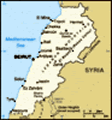Lebanese Economy, Lebanon Economy
Advertisement
Economy - overview: The 1975-91 civil war seriously damaged Lebanon's economic infrastructure, cut national output by half, and all but ended Lebanon's position as a Middle Eastern entrepot and banking hub. In the years since, Lebanon has rebuilt much of its war-torn physical and financial infrastructure by borrowing heavily - mostly from domestic banks. In an attempt to reduce the ballooning national debt, the HARIRI government began an austerity program, reining in government expenditures, increasing revenue collection, and privatizing state enterprises. In November 2002, the government met with international donors at the Paris II conference to seek bilateral assistance in restructuring its massive domestic debt at lower rates of interest. Substantial receipts from donor nations stabilized government finances in 2003, but did little to reduce the debt, which stood at nearly 180% of GDP. In 2004 the HARIRI government issued Eurobonds in an effort to manage maturing debt, and the KARAMI government has continued this practice. However, privatization of state-owned enterprises had not occurred by the end of 2004, as promised during the Paris II conference.
GDP: 3.1% (FY99) (2004)
GDP - real growth rate: 4% (2004 est.)
GDP - per capita: Purchasing power parity - $5,000 (2004 est.)
GDP - composition by sector: Agriculture: 12% industry: 21% services: 67% (2000)
Population below poverty line: 28% (1999 est.)
Household income or consumption by percentage share: Lowest 10%: NA highest 10%: NA
Distribution of family income - Gini index:
Inflation rate (consumer prices):
Labor force: 2.6 million note: in addition, there are as many as 1 million foreign workers (2001 est.)
Labor force - by occupation: Agriculture NA, industry NA, services NA
Unemployment rate: 18% (1997 est.)
Budget: Revenues: $4.895 billion expenditures: $6.642 billion, including capital expenditures of NA (2004 est.)
Industries: Banking, food processing, jewelry, cement, textiles, mineral and chemical products, wood and furniture products, oil refining, metal fabricating
Industrial production growth rate: NA
Electricity - production: 8.066 billion kWh (2002)
Electricity - production by source:
Electricity - consumption: 8.591 billion kWh (2002)
Electricity - exports: 0 kWh (2002)
Electricity - imports: 1.09 billion kWh (2002)
Oil - production: 0 bbl/day (2001 est.)
Oil - consumption: 107,000 bbl/day (2001 est.)
Oil - exports: NA
Oil - imports: NA
Oil - proved reserves:
Natural gas - production:
Natural gas - consumption:
Natural gas - exports:
Natural gas - imports:
Natural gas - proved reserves:
Agriculture - products: Citrus, grapes, tomatoes, apples, vegetables, potatoes, olives, tobacco; sheep, goats
Exports: $1.783 billion f.o.b. (2004 est.)
Exports - commodities: Authentic jewelry, inorganic chemicals, miscellaneous consumer goods, fruit, tobacco, construction minerals, electric power machinery and switchgear, textile fibers, paper
Exports - partners: Syria 24.9%, UAE 10%, Turkey 6.9%, Switzerland 6.7%, Saudi Arabia 5.3% (2004)
Imports: $8.162 billion f.o.b. (2004 est.)
Imports - commodities: Petroleum products, cars, medicinal products, clothing, meat and live animals, consumer goods, paper, textile fabrics, tobacco
Imports - partners: Italy 11.2%, France 10.3%, Syria 9.8%, Germany 8.6%, China 5.8%, US 5.5%, UK 4.6% (2004)
Debt - external: $15.84 billion (2004 est.)
Economic aid - recipient: $2.2 billion received (2003), out of the $4.2 billion in soft loans pledged at the November 2002 Paris II Aid Conference
Currency:
Currency code:
Exchange rates: Lebanese pounds per US dollar - 1,507.5 (2004), 1,507.5 (2003), 1,507.5 (2002), 1,507.5 (2001), 1,507.5 (2000)
Fiscal year: Calendar year
Advertisement
The information here has been derived from Public Domain Sources such as the CIA World Factbook. No liability can be taken for any inaccuracies.
Tot: 0.055s; Tpl: 0.019s; cc: 6; qc: 6; dbt: 0.013s; 1; m:domysql w:travelblog (10.17.0.13); sld: 1;
; mem: 1.1mb

 Lebanon has made progress toward rebuilding its political institutions since 1991 and the end of the devastating 15-year civil war. Under the Ta'if Accord - the blueprint for national reconciliation - the Lebanese have established a more equitable po...
Lebanon has made progress toward rebuilding its political institutions since 1991 and the end of the devastating 15-year civil war. Under the Ta'if Accord - the blueprint for national reconciliation - the Lebanese have established a more equitable po...
